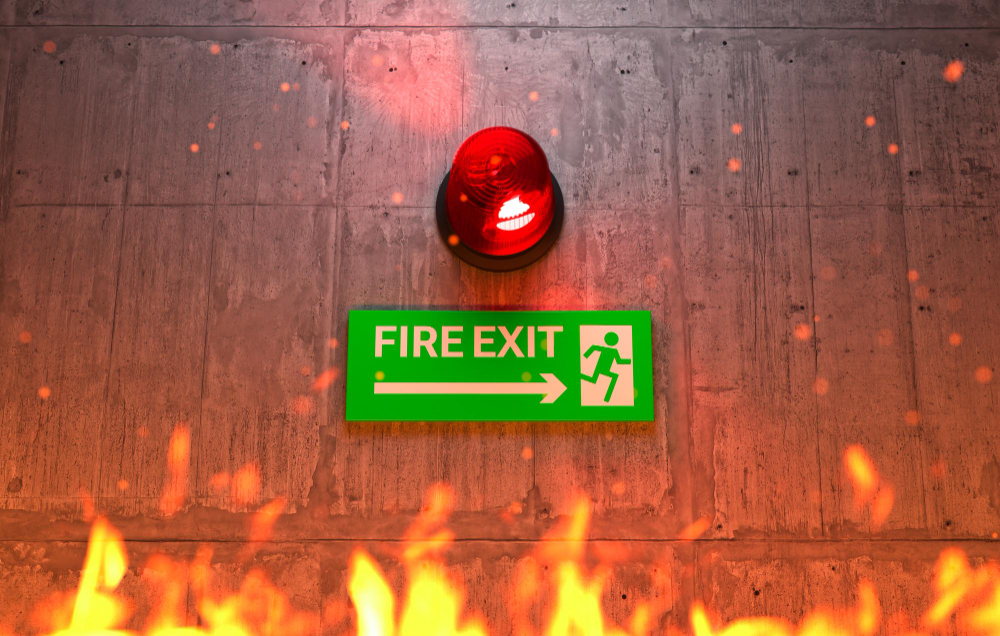Perbedaan Heat Detector dan Smoke Detector untuk Sistem Keamanan Gedung

Perbedaan heat detector dan smoke detector untuk sistem keamanan gedung mungkin belum banyak diketahui. Padahal, keduanya merupakan perangkat yang penting sebagai bagian dari sistem peringatan bahaya kebakaran.
Baik heat detector maupun smoke detector adalah alat yang digunakan untuk memberikan sinyal saat terjadi potensi bahaya seperti asap dan panas yang berlebihan di dalam gedung.
Dengan demikian, penghuni gedung bisa langsung mengambil tindakan cepat untuk menyelamatkan diri. Tanpa adanya sistem peringatan, di gedung yang luas, bisa saja penghuni tidak menyadari akan bahaya yang mengintai.
Berikut perbedaan heat detector dan smoke detector untuk sistem keamanan gedung yang wajib Anda ketahui agar keselamatan bisa tetap terjaga.
Baca Juga: Fungsi Inverter Variable Speed Drive (VSD) pada Motor Listrik dan Peralatan Industri
Pengertian dan Fungsi Heat Detector
Heat detector adalah alat yang dirancang untuk mendeteksi panas yang dihasilkan oleh api atau peningkatan suhu di sekitarnya.
Alat ini biasanya dipasang di langit-langit atau dinding bangunan dan bekerja dengan memonitor suhu lingkungan. Ketika suhu melebihi ambang batas yang telah ditetapkan, heat detector akan mengaktifkan alarm peringatan.
Fungsi heat detector yang paling utama adalah memberikan sinyal peringatan kepada penghuni gedung akan adanya peningkatan suhu dan potensi kebakaran yang disebabkan oleh panas, tanpa bergantung pada asap atau api yang terlihat.
Dengan adanya heat detector, penghuni gedung dapat mengambil tindakan pencegahan atau evakuasi yang cepat dan tepat.
Pengertian dan Fungsi Smoke Detector
Berbeda dengan heat detector, smoke detector adalah alat yang dirancang untuk mendeteksi keberadaan asap di dalam suatu ruangan.
Fungsi smoke detector adalah untuk memberikan peringatan dini kepada penghuni ruangan tentang adanya potensi bahaya kebakaran.
Ketika asap terdeteksi oleh sensor pada smoke detector, perangkat ini akan menghasilkan suara peringatan atau sinyal yang dapat memicu alarm kebakaran, memberikan waktu sedini mungkin bagi penghuni untuk keluar dari area yang berpotensi bahaya.
Smoke detector biasanya menggunakan sensor yang berbeda, seperti ionization smoke detector dan photoelectric smoke detector, untuk mendeteksi keberadaan asap.
Ionization smoke detector mendeteksi asap melalui ionisasi partikel di udara yang terkait dengan pembakaran, sementara photoelectric smoke detector menggunakan cahaya untuk mendeteksi perubahan kepadatan udara akibat asap.
Kedua jenis sensor ini bekerja dengan cara yang berbeda namun memiliki tujuan yang sama, yaitu mendeteksi adanya asap dan mengaktifkan alarm kebakaran.
Powered by Froala Editor

Perbedaan Heat Detector dan Smoke Detector
Heat detector dan smoke detector merupakan dua jenis perangkat yang umum digunakan dalam sistem proteksi kebakaran, namun keduanya berfungsi dengan cara yang berbeda.
Perbedaan heat detector dan smoke detector terletak pada objek yang dideteksi. Heat detector mendeteksi perubahan suhu yang signifikan di sekitarnya. Perangkat ini umumnya bereaksi terhadap suhu yang naik secara cepat atau suhu yang melebihi ambang batas tertentu.
Heat detector cocok digunakan di area yang memiliki asap atau debu secara normal, seperti pabrik atau ruang mesin, di mana smoke detector tradisional tidak dapat bekerja secara akurat.
Sementara itu, smoke detector, seperti namanya, bekerja dengan mendeteksi adanya asap di lingkungan sekitarnya. Perangkat ini mendeteksi partikel-partikel asap yang hadir dalam udara.
Smoke detector sangat efektif dalam mendeteksi kebakaran yang baru berkembang, terutama di area yang tidak terlalu panas.
Di sisi lain, heat detector terhitung kurang sensitif terhadap pencemaran oleh debu atau asap, sehingga cocok untuk lingkungan yang keras atau berdebu.
Perbedaan heat detector dan smoke detector yang utama adalah metode deteksi keduanya. Heat detector mengandalkan perubahan suhu, sementara smoke detector mengandalkan deteksi asap.
Oleh karena itu, pemilihan antara heat detector dan smoke detector bergantung pada kondisi lingkungan dan kebutuhan spesifik setiap lokasi.
Misalnya, di ruang mesin yang berdebu, heat detector mungkin lebih cocok, sedangkan di ruangan perkantoran atau hotel, smoke detector lebih disarankan karena kemampuannya mendeteksi kebakaran dengan cepat.
Baca Juga: 7 Cara Mengetahui Sumber Korsleting Listrik yang Akurat untuk Cegah Bahaya Kebakaran
Perbedaan heat detector dan smoke detector memberikan keamanan untuk melindungi penghuni gedung dengan fungsi dan kinerjanya masing-masing. Mengetahui perbedaan keduanya dapat membantu Anda memasang perangkat yang tepat untuk sistem alarm kebakaran yang sesuai dengan kondisi lingkungan.
Powered by Froala Editor
Related News



